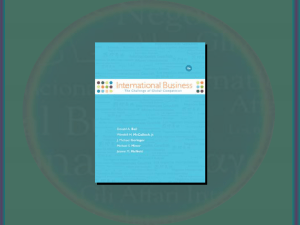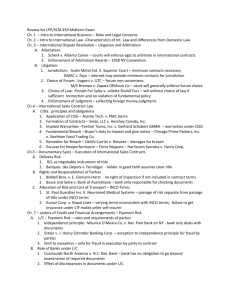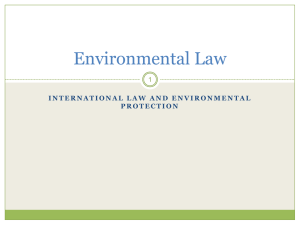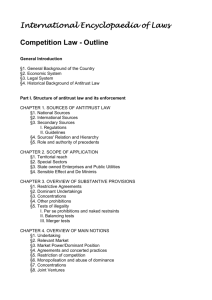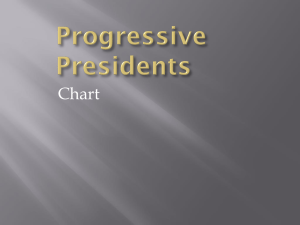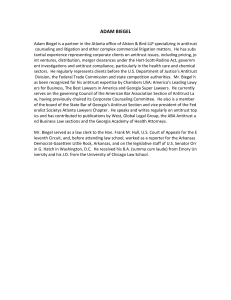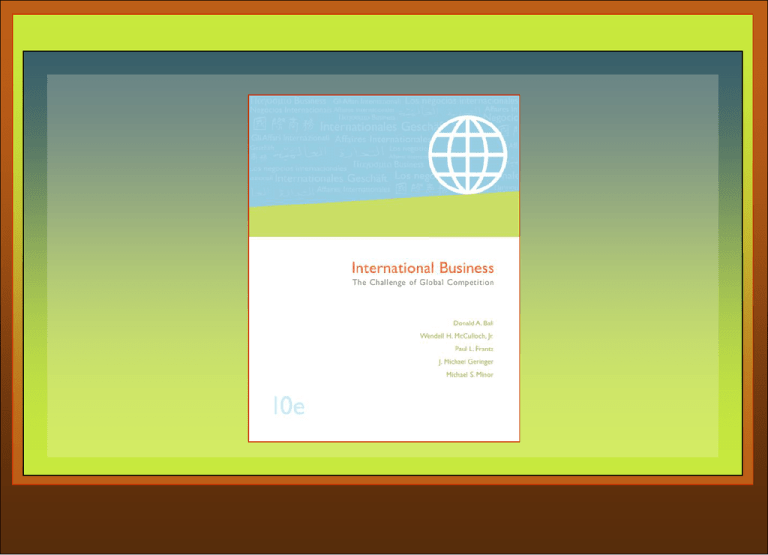
This chapter covers:
10
•Legal forces that
confront international
business
•The importance of
foreign law
Legal Forces
•International
contracts
•Protection of
intellectual property
•Purposes of taxes
•Enforcement of
antitrust laws
•Product liability
International Business
by Ball, McCulloch, Frantz,
Geringer, and Minor
McGraw-Hill/Irwin
Copyright © 2006 The McGraw-Hill Companies, Inc. All rights reserved.
Chapter Objectives
Appreciate the complexity of the legal forces that confront
international business
Recognize the importance of foreign law
Understand contract devices and institutions that assist in
interpreting international contracts
Anticipate the need and methods to protect your intellectual
properties
Understand that many taxes have purposes other than to raise
revenue
Discuss enforcement of antitrust laws
Appreciate the risk of product liability legal actions
Discuss U.S. laws that affect international business operations
10-2
International Legal Forces
Rule of law allows foreign
businesses to know interests
will be protected
Public International Law
Legal relations between
governments
Private International Law
Laws governing
transactions of
individuals and
companies
10-3
Sources of International Law
The most important source is found in bilateral and
multilateral treaties between nations.
Treaties are agreements between countries and also
may be called conventions, covenants, compacts, or
protocols
United Nation’s International Court of Justice
creates law when it decides disputes
U.S. Congress determines whether treaties have
precedence over other federal laws and treaties
International rules derived from customs and usage
10-4
Extraterritoriality
10-5
The attempt to enforce
domestic laws outside
of a country’s borders
Practiced by many
countries including
the U.S. and EU
Not done through
force, but by
traditional legal
means
International Dispute Settlement
Litigation in the United States
The U.S. has well-developed court systems that facilitate
litigation.
These court systems handle both criminal and civil
matters.
One reason many people outside the U.S. dislike
litigation in the U.S. is the process of discovery.
Unlike most other countries, the U.S. has two major
court systems.
The federal court system and the system of state
courts.
10-6
Issues Surrounding
Performance of Contracts
A major problem usually
involved in cross-border
litigation is
The question of which
jurisdiction’s law should
apply and in which
location the litigation
should occur.
Each country has laws to
determine this
Final decision rests with
the courts
10-7
United Nations Solutions
Many countries,
including the U.S., have
ratified the UN
Convention on Contracts
for International Sales of
Goods (CISG)
CISG established
uniform legal rules to
govern international sales
contracts
CISG is automatically
applied
Issues Surrounding
Performance of Contracts
Private Solutions,
Arbitration
10-8
Instead of going to court
in any country,
companies may opt for
arbitration.
Quicker
Less expensive
More private
Many cases handled in
Paris, London and NY
Enforcement of Foreign Arbitration
Awards
The UN Convention on the Recognition and
Enforcement of Foreign Arbitral Awards
The U.S. and most UN member-countries of
industrial importance have ratified this
convention
Binds ratifying countries to compel arbitration
when the parties have so agreed in their contract
and to enforce the resulting awards
10-9
Intellectual Property
Intellectual property
includes
Patents
Trademarks
Trade names
Copyrights
Trade secrets
All result from the exercise
10-10
of someone’s intellect.
Each country protects in
their own fashion
Intellectual Property
Patents (Protection)
International Convention
for the Protection of
Industrial Property
European Patent
Organization
The World Intellectual
Property Organization
10-11
Trademarks
Protection varies from
country to country which
may be from 10 to 20
years.
Madrid Agreement of
1891
General American
Convention for
Trademark and
Commercial
Protection.
European Trademark
Office
Intellectual Property
Trade Names
Trade names are protected in all countries that
adhere to the Convention for the Protection of
Industrial Property
Copyrights
Protection is provided under the Berne Convention of
1886 adhered to by 77 countries
Universal Copyright Convention of 1954 adopted by
92 countries
10-12
Common Law or Civil Law
Common Law
Courts made
common law as they
decided individual
cases
Judges in a common
law jurisdiction have
the power to
interpret the law
10-13
Civil Law
Civil law was made
by king, princes, or
legislatures issuing
decrees or passing
bills
Judges in a civil law
jurisdiction have the
power only to apply
the law
Differences between the
U.S. and England
England has a split legal
profession with barristers and
solicitors
No jury for civil court actions
No contingency fee in court
cases
The losing party in England
must pay most of the court costs
of the winning party
In England, parties generally
are entitled to receive a list of
witnesses with a brief
explanation of the expected
testimony.
10-14
Standardizing Laws
Many attempts have been made to standardize laws among
various nations
International business flows much better with a uniform set of
rules
Attempts include
Tax conventions and treaties
Antitrust cooperation
International Center for Settlement of Investment Disputes
UN Convention on International Sale of Goods
International Organization for Standardization (ISO)
International Electrotechnical Commission (IEC)
10-15
Taxation
10-16
Nonrevenue tax purposes
Redistribute income
Discourage consumption
of certain products
Encourage the purchase
of domestic rather than
imported products
To discourage investment
abroad
To achieve equality of
taxes paid
National Differences of Approach
Tax Levels
Range from relatively
high in some Western
European countries to
zero in tax havens
Some countries have
capital gains taxes, and
some do not
A capital gain is
realized when an asset
is sold for an amount
greater than its cost
10-17
Tax Types
Capital gains tax
Income tax
Value-added tax
Common in
industrialized countries
Tax based on the value of
goods and services
Used in Europe
WTO permits rebate on
VAT
Unitary tax
Tax Laws and Regulations
From country to country, the complexity of tax
systems differ
Compliance with tax laws and their enforcement
vary widely
Many consider tax laws and regulations of the U.S. the
most complex
Germany and U.S. strict, Italy and Spain relatively lax
Other differences include
10-18
Tax incentives, exemptions, costs, depreciation allowances,
foreign tax credits, timing, and double corporate taxation
Taxation
Tax Treaties or Conventions
Differences between nations’ tax practices have
resulted in many signing tax treaties with each
other.
The presence or absence of a tax treaty is often
a factor in international business and
investment location decisions.
The U.S. has tax treaties with over 50 countries.
10-19
Taxation
Ecommerce and the ease of
shifting operations and
residences is making it
easier to avoid taxes
U.S. applies National Tax
Jurisdiction, taxing citizens
regardless of where they live
and work
Almost all other countries
apply Territorial Tax
Jurisdiction which exempts
citizens who neither work
nor live in the country
10-20
Antitrust Laws
Antitrust laws are intended to prevent monopolies
The U.S. antitrust laws are strict vigorously enforced
The EU is becoming more active in the antitrust field
Differences between U.S. and other nations’ antitrust laws
include the per se concept and the application of both civil and
criminal penalties
The U.S. and the EU have attempted to enforce their antitrust
laws extraterritorially
Japan’s Fair Trade Commission has been nicknamed the
“toothless tiger”, but the Japanese companies are
incorporating antitrust thinking into their strategies
10-21
Tariffs, Quotas, and Other
Trade Obstacles
Purposes of tariffs
To raise revenue for the
government
To protect domestic
producers
Quotas limit the number or
amount of imports
For protection
U.S. can impose retaliatory
barriers
10-22
Other protection obstacles
include
Health requirements
Packaging requirements
Language requirements
Weak patent or trademark
protection
Quarantine periods
Voluntary Restraint
Agreements
Product Liability
Product Liability
Holding a company and its officers and directors
liable and possibly subject to fines or
imprisonment when their product causes death,
injury, or damage
Strict Liability
Holds the designer/manufacturer liable for
damages caused by a product without the need
for a plaintiff to prove negligence in the
product’s design or manufacture
10-23
Product Liability
Differences in U.S. law
10-24
No restrictions on amount of
money damages that can be
awarded
Rigid enforcement of strict
liability, no need to prove
negligence
U.S. lawyers take cases on a
contingency fee basis
Outside the U.S., when a
defendant wins, the plaintiff
must pay all court costs
U.S. Product liability cases
are heard by juries
Discovery available in U.S.
Currency Exchange Controls
Exchange Control Generalities
In countries where hard foreign currency is scarce, a
government agency allocates it.
People entering such a country must declare how much
currency of any kind there are bringing in and also how
much they are taking out.
The intent is twofold
To discourage travelers from bringing in the host
country’s national currency brought abroad at a better
exchange rate
To encourage travelers to bring in hard foreign
currency
10-25
U.S. Laws That Affect U.S. Firms
International Business
Federal Employment Laws
Title VII of the CRA of 1964
ADEA and ADA
Foreign Corrupt Practices Act (FCPA)
Questionable or dubious payments by American
companies to foreign officials revealed in 1970’s
Congress passed FCPA outlawing bribery, but not
“grease” payments
Accounting Law – Sarbanes-Oxley Act
10-26
Established reporting requirements
Current International Court of Justice
President
Shi Jiuyong (China)
Vice-President
Raymond Ranjeva
(Madagascar)
Judges
Gilbert Guillaume (France)
Abdul G. Koroma (Sierra
Leone)
Vladlen S. Vereshchetin
(Russian Federation)
Rosalyn Higgins
(United Kingdom)
10-27
Gonzalo Parra-Aranguren
(Venezuela)
Pieter H. Kooijmans
(Netherlands)
Francisco Rezek (Brazil)
Awn Shawkat AlKhasawneh (Jordan)
Thomas Buergenthal
(United States of America)
Nabil Elaraby (Egypt)
Hisashi Owada (Japan)
Bruno Simma (Germany)
Peter Tomka (Slovakia)
KEY EVENTS IN A MULTILATERAL TREATY
10-28
Facts and figures on International Court of
Arbitration in 2003
580 Requests for Arbitration were filed with the ICC Court;
those Requests concerned 1,584 parties from 123 different countries
and independent territories;
in 11% of cases at least one of the parties was a state, parastatal or
public entity;
the place of arbitration was located in 47 different countries
throughout the world;
arbitrators of 69 different nationalities were appointed or confirmed
under the ICC Rules;
the amount in dispute exceeded one million US dollars in 55,3% of
new cases;
369 awards were rendered
10-29
International Standards Organization
10-30
President Lyndon B. Johnson signs the
Civil Rights Act of 1964, July 2, 1964
10-31

